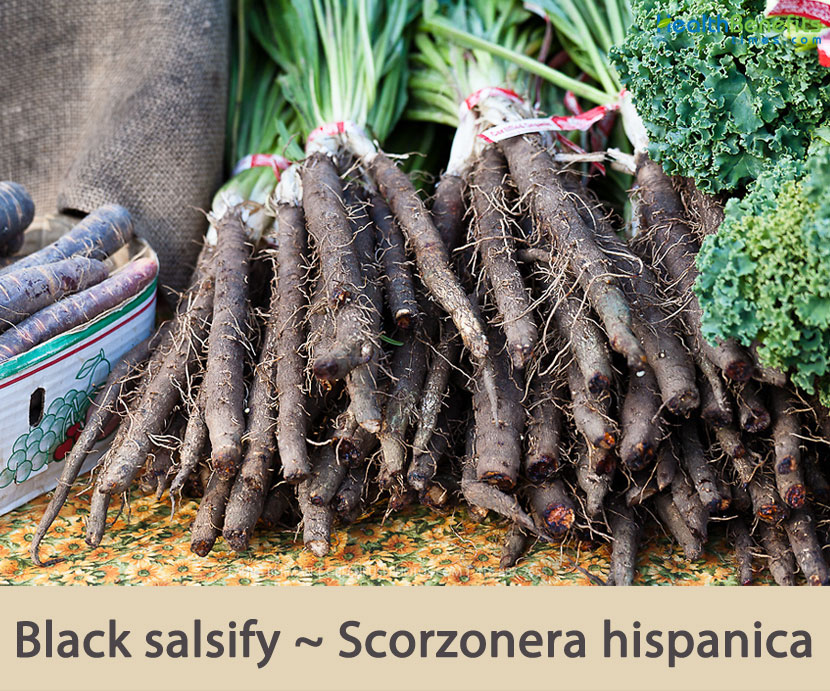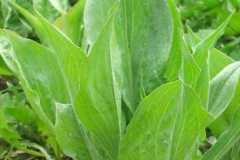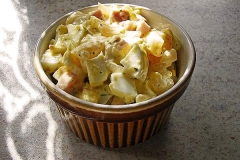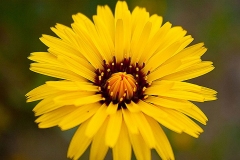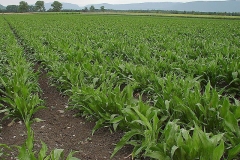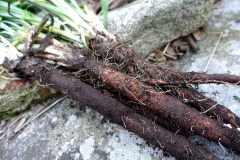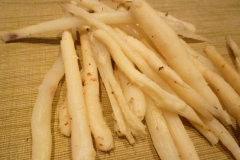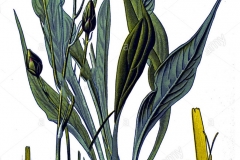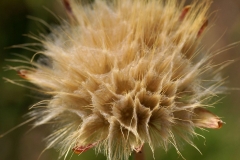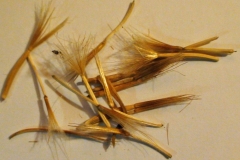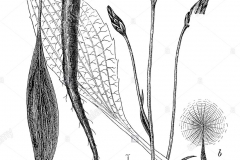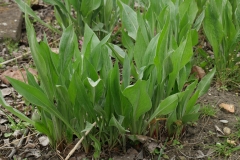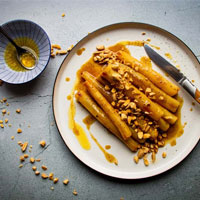| Black salsify Quick Facts | |
|---|---|
| Name: | Black salsify |
| Scientific Name: | Scorzonera hispanica |
| Origin | Central and southern Europe, North Africa, and Asia, and it has been introduced to North America |
| Shapes | Achene up to 2 cm long, with dirty white, plumose pappus |
| Health benefits | Support Weight Loss, hair health, Brain Health, Healthy Bones, Digestion, blood glucose, Cancer, PMS, blood pressure and promotes healthy Hair Growth |
| Name | Black salsify |
|---|---|
| Scientific Name | Scorzonera hispanica |
| Native | Central and southern Europe, North Africa, and Asia, and it has been introduced to North America |
| Common Names | Block Salsify, Scorzonera, Black-salsify, Spanish-salsify, Black oyster plant, Common viper’s-grass, Black salsify, Black Oyster Plant, Lettuce Salsify, Spanish Salsify, Serpent Root, Viper’s Grass, Viper’s Herb |
| Name in Other Languages | Albanian: Skorzonerë e Spanjës Arabic: Salsafiun hisbaniun (سلسفي هسباني) Azerbaijani: İspan təkəsaqqalı Basque: Eskortzonera, astobela, sendapokia, terebuza Belarusian: Skorconera (Скарцанера) Bulgarian: Ispanski kokesh (Испански кокеш) Catalan: Escurçonera de nap, barballa, escurçonera, escurçonera hispànica, farinetes, herba escurçonera, salsafi Chinese: Ou zhou ya cong, Hēi póluómén shēn (黑婆罗门参) Croatian: Spanjolski zmijak Czech: Hadí mord španělský Danish: Skorzoner, Skorzonerrod, Have-skorsoner Dutch: Schorseneer, Grote schorseneer English: Common viper’s grass, Scorzonera, Black salsify, Viper’s grass, Spanish-salsify, Black oysterplant, Lettuce Salsify, Estonian: Aed-mustjuur Finnish: Mustajuuri French: Salsifis noir, Scorsonère, Scorsonère d’Espagne, Scorsonère géant de Russie, Salsifis noir, Asperge d’hiver Galician: Escorzoneira German: Geissbart, Schwarzwurzel, Winterspargel, Garten-Schwarzwurzel, Gemüse-Schwarzwurzel, Schwarzwurz, Spanische Schwarzwurzel, echte Schwarzwurzel Hungarian: Spanyol pozdor, feketegyökér Italian: Scorzonera, Scorzonera di Spagna, Scorzonera con foglie di Gladiolo, Viperaria, viperina Japanese: Kiku gobou, Sukorutsu~onerahisupanika (スコルツォネラヒスパニカ) Korean: Geom-eunsoechae (검은쇠채) Kurdish: Sping Latin: Scorzonera Latvian: Melnsakne Lithuanian: Valgomoji gelteklė Netherlands: Schorseneer Norwegian: Svartrot Occitan: Escorçonèra, salsefic negre Polish: Wezymord, Wezymord czarny, Wezymord czarny korsen, Wężymord hiszpański Portuguese: Escorcioneira, Salsifi-negro, Salsifi négro, escorcioneira-da-terra-fria, escorcioneira-eriçada Romanian: Skorconera spaniola (Скорцонерэ спаниолэ), Scorțoneră Russian: Skorconer, Kozelets ispanskiy (Козелец испанский), skorconer (cкорцонер), chernyy koren'(черный корень) Serbian: Zmijak (змијак) Slovak: Cierny koreň Slovene: Spanski gadnjak Spanish: Salsifi negro, Escorzonéra, teta de vaca, almirones, berbajo, churrimana, ercorzonera de hoja ancha, escorcionera mayor, escorcionera real, escurzo, salsifí de España, viperina Swedish: Svartrot Turkish: Sakız out Ukrainian: Skorzonera ispansʹka (скорзонера іспанська) |
| Plant Growth Habit | Cool season perennial crop |
| Growing Climates | Cultivated ground, rocks, bushy places, dry pastures and thickets on rocky ground |
| Soil | Prefers deep, fine textured, welldrained soils with good water holding capacity. Work the soil 18-24 inches deep to reduce compaction so the plants can develop long, straight roots with few deformities. Plants prefer to be within a pH level of 6-8 |
| Plant Size | About 2 feet in height |
| Root | Thin, slender, black taproot grows up to one meter long and up to 2 centimeters (0.8 in) in diameter. It has a black skin with white internal flesh |
| Flesh Color | White-creamy inside |
| Stem | Stems are solitary or few in number, usually branched on the upper part. |
| Leaf | Simple, alternate, and linear to linear-elliptic or lanceolate, more rarely also ovate, with parallel veins, not divided, base with semi-amplexicaul usually persistent sheath, margin entire, flat, or sometimes undulate. They are about 15-40 cm long and 0.5-6 cm wide |
| Flowering season | June to September |
| Flower | Yellowish flower-head are borne at the end of the stems. The flower-heads have yellow ray flowers. The flowers are hermaphrodite in nature |
| Fruit Shape & Size | Achene up to 2 cm long, with dirty white, plumose pappus |
| Seed | Seeds are white, smooth, very long, blunt at one end, and somewhat pointed at the other |
| Plant Parts Used | Whole plant |
| Season | July to September |
| Health Benefits |
|
| Traditional Uses |
|
Plant Description
Black salsify is a cool season perennial crop that normally grows about 3-4 ft. tall. The plant is found growing in cultivated ground, rocks, bushy places, dry pastures and thickets on rocky ground. The plant prefers deep, fine textured, well-drained soils with good water holding capacity. Work the soil 18-24 inches deep to reduce compaction so the plants can develop long, straight roots with few deformities. Plants prefer to be within a pH level of 6-8. The plant has thin; slender, black taproot that grows up to one meter long and up to 2 centimeters (0.8 in) in diameter. It has a black skin with white internal flesh. Roots tend to be longer, smoother, less fibrous, and of a finer texture than regular salsify. It is colder hardy, but requires about the same length growing period as regular salsify, which is 120 days. The stems are solitary or few in number, usually branched on the upper part.
Leaves
The leaves are usually simple, alternate, and linear to linear-elliptic or lanceolate, more rarely also ovate, with parallel veins, not divided, base with semi-amplexicaul usually persistent sheath, margin entire, flat, or sometimes undulate. They are about 15-40 cm long and 0.5-6 cm wide. They are rich in vitamin C, but lack inulin, and they are eaten fresh or blanched, especially in salads.
Flowers
The yellowish flower-head are borne at the end of the stems. The flower-heads have yellow ray flowers. The flowers are hermaphrodite in nature. In other words, the male as well as the female reproductive organs are present in the same flower. Insects pollinate the black salsify flowers. Flowering normally takes place in between June to September.
Fruit
Fertile flowers are followed by achene up to 2 cm long, with dirty white, plumose pappus. Seeds are white, smooth, very long, blunt at one end, and somewhat pointed at the other.
The thick black skin of the salsify root is usually considered inedible and can be removed either prior to or after boiling. If the skin is removed prior to boiling, the peeled root should be immediately immersed in water mixed with vinegar or lemon juice, in order to prevent discoloring. Since the root sap is an extremely sticky latex, it is often more convenient to peel it after boiling the root for 20 to 25 minutes. Black salsify is often eaten together with other vegetables, such as peas and carrots. But it is also popular served like asparagus in a white sauce, such as bechamel sauce or mustard sauce. Boiled salsify roots may also be coated with batter and deep fried.
History
Black salsify is native to Southern Europe and the Near East. As is indicated by its binomial name, it is generally thought to have spread to the rest of Europe from Spain, but the first mention of the vegetable by a Western writer came from Leonhard Rudolf, who reported seeing scorzonera at the market of Aleppo in Syria, in 1575.
The Celtic and Germanic peoples are believed to have eaten the black salsify, which was considered effective against the bubonic plague and snake bites until the 16th century. The plant was being cultivated as a vegetable in Italy and France by 1660 and, soon after, the Belgians were growing vast fields of it.
Pronounced Scorzo-neera, this perennial member of the Asteraceae, the sunflower family is cultivated as a root vegetable in the same way as Salsify (Tragopogon porrifolius), also in the sunflower family. Although Scorzonera closely resembles Salsify in root shape and internal root color, and both are members of the Asteraceae they are not closely related taxonomically.
Health benefits of Black Salsify
Black Salsify is cultivated as a root vegetable. It is also known as Spanish salsify, Viper’s herb, scorzonera, viper’s grass, serpent root, or black oyster plant. The health benefits of black salsify are many. To name a few, it stimulates hair growth, boosts the immunity levels, lowers blood pressure, improves digestive health, increases metabolism, and lots more. Listed below are some of the popular benefits
1. Weight Loss
Although exercise and physical activity is considered the simplest ways to slim down, foods made in fiber additionally do their fair proportion in serving to out. Black Salsify is high in fiber that aids weight loss by serving to management endocrine spikes and up satiation. Plus, salsify is low in calories, creating it a perfect diet food.
2. Promotes hair health
Black salsify hosts an abundance of hair health boosting nutrients such as iron and copper. A 100-gram portion of uncooked black salsify provides almost a fifth of the daily value for iron. Iron helps keep hair follicles healthy by carrying oxygen to the scalp. Research indicates that low levels of iron are one of the most common causes of hair loss in pre-menopausal women.
Also copper is known to combat hair loss and stimulate hair growth. Additionally, it is thought to strengthen hair, intensify hair color and prevent premature graying of hair. A 100-gram serving of black salsify provides 6% of the daily value for copper (or even more, according to some estimates).
3. Improve Brain Health
Black Salsify nutrition is enriched with vitamins that enhance and helps in development of the brain. Antiophthalmic factor helps to reinforce signal physical phenomenon of neurotransmitters by carrying signals from one vegetative cell ending to following.
Additionally black salsify is vital in regulating mood and preventing mental disorders. Some researchers believe that with regular intake of black salsify; facilitate the symptoms of depression and different negative effects on brain-health.
4. For Healthy Bones
Black salsify consists of a high quantity of calcium, copper and magnesium, dietary minerals that are important for support and growth of bone tissue. With the assistance of those minerals, salsify is effective in preventing issues related with bones, like osteoporosis.
Regular intake of Black salsify might even stop inflammatory disease that happens once the animal tissue connected to bones begins to degrade and painful bone rubbing on bone friction happens. Antioxidant supports the synthesis of albuminoid that may be a key part of animal tissue found in joints.
5. Improve Digestion
Dietary fiber helps keep the gastrointestinal system running cleanly. Black salsify consists of a mixture of soluble and insoluble dietary fiber that helps to encourage gut movements. Once eaten, it helps the body absorb nutrients from the food by speed digestion making it helpful to constipation because it regulates the water content of stool and may add bulk to the stool and helps keep waste acquiring the intestines.
It may even prevent colon cancer, and will additionally neutralize some harmful gases that are discharged into the body by minimizing the time waste spends in-tuned with the healthy cells of the colon.
6. Regulate blood glucose
When the body fails to efficiency transport aldohexose from the blood into the cells wherever they’re required, this is often typically an indicator of diabetic unwellness. The main secretion for regulation of blood sugar is endocrine.
Studies counsel that Black salsify can contribute to dominant blood glucose levels, serving to slow the absorption of aldohexose into the blood. This delayed absorption helps endocrine to operate higher, and as a result permits for increased energy production and higher overall health.
7. Fights Cancer
Black salsify is stated to have loads of polyacetylene antioxidants like falcarindiol, falcarinol, methyl-falcarindiol, and panaxydiol. Research concluded that all of these essential compounds exhibit anticancer, antifungal, and anti-inflammatory properties to protect an individual from acute lymphoblastic leukemia and colon cancer. An additional benefit is that its vitamin C content fights oxidative stress, which further prevents the healthy cells from developing into cancerous cells.
8. Improve Symptoms of PMS
Black salsify consists of good amount of calcium that might help alleviate mood swings, breast tenderness, pain and anxiety, all of that occur throughout pre-menstruation. If left unattended to, it should have an effect on way of life and emotional activities. Salsify might facilitate to bring relief to the symptoms of premenstrual syndrome, serving to create the monthly prevalence a less nerve-racking one.
9. Stimulates the growth of bifido-bacteria
Black salsify is one of the best dietary sources of inulin. Inulin is a type of prebiotic fiber that offers a number of health benefits, most of which have been attributed to the ability of inulin to boost the growth of bifido-bacteria in the human body. Bifidobacteria are anaerobic, rod-shaped bacteria that live in the large intestines of most mammals, including humans. They are beneficial to human health as they can reduce the concentrations of harmful bacteria and carcinogenic enzymes in the intestines, cure constipation and have a positive effect on the immune system.
https://www.youtube.com/watch?v=gL7TR-kK764
10. Boost immune system
Vitamin C is well-known to scale back your risk of infections once taken throughout cold season, preventing pathogens from damaging cells and tissues. The amount of antioxidant in scorzonera hispanica helps enhance the system.
Once there’s an accumulation of antioxidant in somatic cells, the method of bodily function is increased and there’s increased destruction of harmful microbes. On the opposite hand, a deficiency of antioxidant might result in impaired immunity and prone to infections. Antioxidant is important, because the body is unable to provide it on its own.
11. Regulate blood pressure
Kidneys are accountable to an outsized extent for regulation of blood pressure, though the general public don’t appreciate or apprehend this. Black salsify consists of a correct balance of dietary minerals that may regulate vital sign, like a high quantity of calcium and potassium, and an occasional quantity of sodium, that along facilitate to optimize vital sign. Kidneys facilitate to manage the fragile balance between potassium and sodium.
Once there’s excess sodium, this fragile balance is discontinuous and there’s an accumulation of fluid which ends in higher blood pressure. To revive balance, foods made in calcium and potassium, like immune ought to be consumed to counter the impact of sodium and restoring physiological condition, thus, helping the excretory organ to function properly.
12. Promotes Healthy Hair Growth
Black Salsify contains a moderate quantity of iron that encourages steady and regular hair growth. It’s believed that the flow of blood into the scalp is also increased since iron may be a basic issue accountable for the formation of red vegetative cell. Once there’s magnified red blood provide to the vesicle beds, they stimulate hair growth and promote thick hair.
It should additionally cut back the speed of premature hair growth or loss of hair, which might be impaired by inefficient blood flow. Iron in Black salsify promotes a healthy scalp for scalp treatment and as a tonic for the hair
13. Improved Skin
Black salsify consists of extremely effective nutrients like antiophthalmic factor and vitamin C which might facilitate to eradicate signs of aging, and preserve your vernal look for years to return. The skin starts showing aging signs once there’s a deficiency of albuminoid within the body, or as results of excessive aerophilic processes current within the body.
Black salsify will facilitate to boost albuminoid synthesis so as to keep up skin elasticity; structure, strength and color, by virtue of its antioxidant content, that additionally assists within the fight against diseases and helps to exchange dead cells that aren’t helpful to the skin. These effects end in an improvement to the looks of skin, feat you beaming and vernal.
14. Prevents the Risk of Major Disorders
Black salsify is a rich source of manganese; it plays a key role in maintaining the health of various enzymes in the body. It controls blood sugar, looks after thyroid function, and takes care of energy metabolism. Single bowl of salsify serves about 18% of the suggested manganese dosage. Deficiency in manganese can cause impaired fertility, birth defects, general weakness, and growth retardation.
Culinary Uses
- Root can be cooked and has a sweet agreeable flavor.
- Root is usually eaten at the end of its first year of growth, but it can be grown on for a second year without becoming tough.
- Tender young shoots are usually eaten in early spring.
- Flower buds can be consumed raw.
- Flower buds can be added to salads.
- Petals have their own distinctive flavor and can also be added to salads.
- Roasted root is used as a coffee substitute.
- Leaves can also be used as fresh greens for salads.
- Scorzonera roots are used as a cooked vegetable.
- In Europe, they are among the many canned and frozen commercial vegetables (‘salsifis’ in France).
- The roots have been used like chicory.
- Roots are scraped or peeled, sliced into sections and then cooked, steamed or sautéed and served with white meat dishes.
- Cooked and pureed root may be coated with flour and deep-fried to make salsify fritters.
Black Salsify with Toasted Almonds, Honey and Black Pepper
Ingredients
- 8 pc black salsify Look for firm stalks
For Braising the Salsify
- 600 ml chicken stock Or vegetable stock or just water
- 2 tbsp. honey
- ⅛ tsp salt
- 1 tbsp. butter
- 1 pc bay leaf
- 1 pc lemon cut in half
For Finishing
- 100 ml dry white wine
- 2 tbsp. almonds skinless and blanched
- 2 tbsp. butter cold
- black pepper freshly cracked
Directions
- Wash off as much dirt as possible from the salsify. This will make peeling a lot easier.
- Fill a bowl or casserole dish large enough to fit the salsify in with cold water. Cut one lemon in half and add the juice to this water to make an acidulated water.
- Using gloves, peel the salsify. Trim off the ends and cut in half. Keep the stalks submerged in the lemon water.
- Add all of the ingredients “for braising the salsify” in a large pot with the peeled salsify. Bring to a boil and reduce to a simmer. Cook until the stalks are soft but with a slight resistance when poked with a knife – just like cooking carrots. Approx. 10 minutes.
- Let the stalks cool in the liquid for at least 10 minutes.
- Remove the stalks from the braising liquid and dry on paper towel. Save the braising liquid for later.
- Toast the almonds in the oven at 160°C/375°F for about 5 minutes or until golden brown. Roughly chop and set aside for later.
- Heat a pan with 1 tbsp. of butter of medium heat and wait until it foams. Add the salsify and brown them in the butter.
- Remove the salsify from the pan and save the extra browned butter on the side for later in a small bowl.
- Deglaze the pan with the white wine and reduce by half. Add 100 ml of the braising liquid and continue cooking until it starts to look saucy. About 2-3 minutes.
- Add the salsify back to the pan and finish the sauce with a knob of cold butter and swirl in pan off the heat.
- Season with salt to taste, a squeeze of fresh lemon juice and garnish with black pepper and the toasted almonds. Drizzle a little of the reserved brown butter on top (optional). Enjoy!
References:
https://www.itis.gov/servlet/SingleRpt/SingleRpt?search_topic=TSN&search_value=505091#null
https://npgsweb.ars-grin.gov/gringlobal/taxon/taxonomydetail?id=33412
https://pfaf.org/User/Plant.aspx?LatinName=Scorzonera+hispanica
https://gd.eppo.int/taxon/SCVHI
http://www.theplantlist.org/tpl1.1/record/gcc-80660
https://www.cabi.org/isc/datasheet/49333
https://www.nordic-baltic-genebanks.org/gringlobal/taxonomydetail.aspx?id=33412
https://en.wikipedia.org/wiki/Scorzonera_hispanica
https://edis.ifas.ufl.edu/publication/MV131
https://uses.plantnet-project.org/en/Scorzonera_hispanica_(PROTA)
http://temperate.theferns.info/plant/Scorzonera+hispanica
https://www.flowersofindia.net/catalog/slides/Black%20Salsify.html
https://plants.usda.gov/home/plantProfile?symbol=SCHI2


